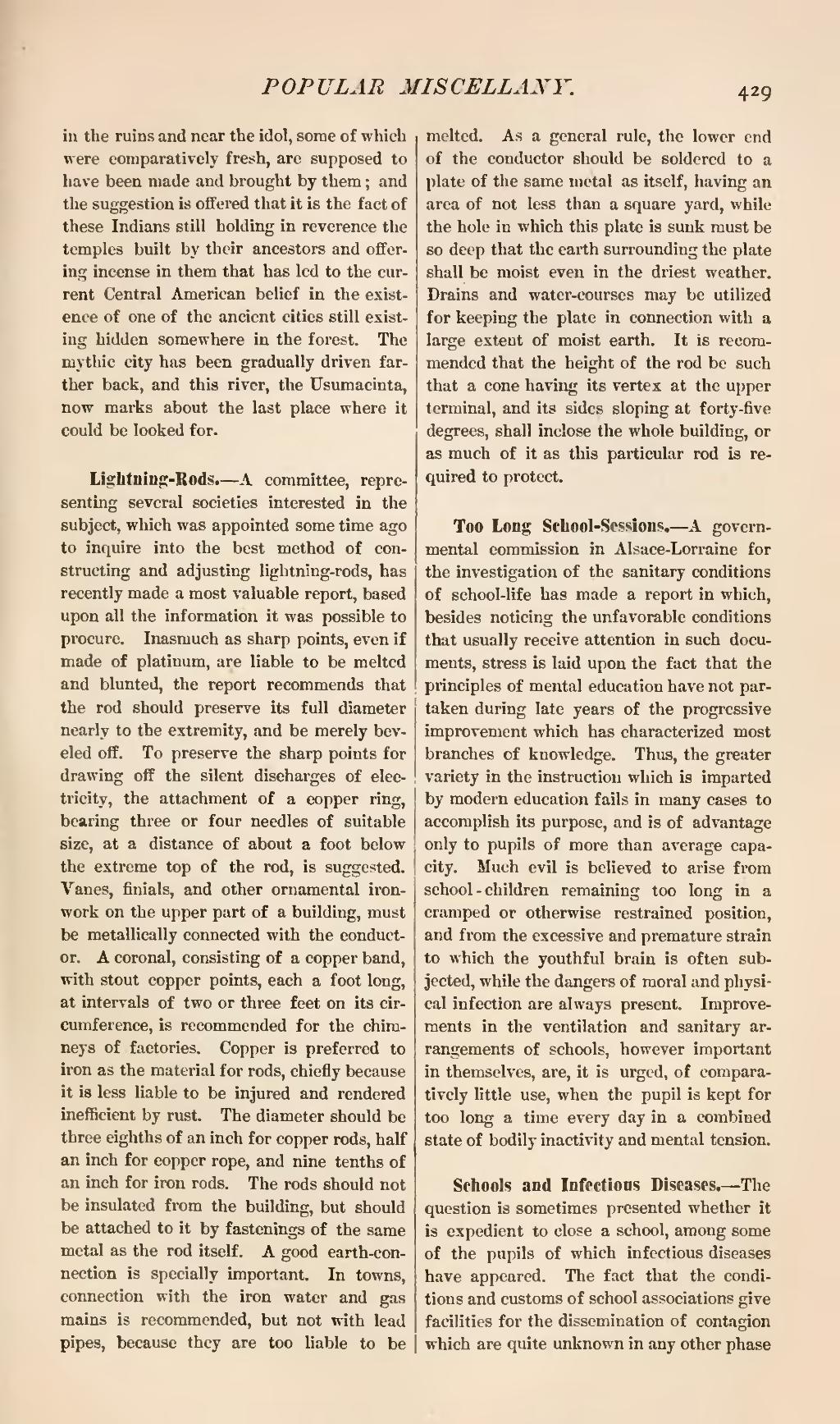in the ruins and near the idol, some of which were comparatively fresh, are supposed to have been made and brought by them; and the suggestion is offered that it is the fact of these Indians still holding in reverence the temples built by their ancestors and offering incense in them that has led to the current Central American belief in the existence of one of the ancient cities still existing hidden somewhere in the forest. The mythic city has been gradually driven farther back, and this river, the Usumacinta, now marks about the last place where it could be looked for.
Lightning-Rods.—A committee, representing several societies interested in the subject, which was appointed some time ago to inquire into the best method of constructing and adjusting lightning-rods, has recently made a most valuable report, based upon all the information it was possible to procure. Inasmuch as sharp points, even if made of platinum, are liable to be melted and blunted, the report recommends that the rod should preserve its full diameter nearly to the extremity, and be merely beveled off. To preserve the sharp points for drawing off the silent discharges of electricity, the attachment of a copper ring, bearing three or four needles of suitable size, at a distance of about a foot below the extreme top of the rod, is suggested. Vanes, finials, and other ornamental ironwork on the upper part of a building, must be metallically connected with the conductor. A coronal, consisting of a copper band, with stout copper points, each a foot long, at intervals of two or three feet on its circumference, is recommended for the chimneys of factories. Copper is preferred to iron as the material for rods, chiefly because it is less liable to be injured and rendered inefficient by rust. The diameter should be three eighths of an inch for copper rods, half an inch for copper rope, and nine tenths of an inch for iron rods. The rods should not be insulated from the building, but should be attached to it by fastenings of the same metal as the rod itself. A good earth-connection is specially important. In towns, connection with the iron water and gas mains is recommended, but not with lead pipes, because they are too liable to be melted. As a general rule, the lower end of the conductor should be soldered to a plate of the same metal as itself, having an area of not less than a square yard, while the hole in which this plate is sunk must be so deep that the earth surrounding the plate shall be moist even in the driest weather. Drains and water-courses may be utilized for keeping the plate in connection with a large extent of moist earth. It is recommended that the height of the rod be such that a cone having its vertex at the upper terminal, and its sides sloping at forty-five degrees, shall inclose the whole building, or as much of it as this particular rod is required to protect.
Too Long School-Sessions.—A governmental commission in Alsace-Lorraine for the investigation of the sanitary conditions of school-life has made a report in which, besides noticing the unfavorable conditions that usually receive attention in such documents, stress is laid upon the fact that the principles of mental education have not partaken during late years of the progressive improvement which has characterized most branches of knowledge. Thus, the greater variety in the instruction which is imparted by modern education fails in many cases to accomplish its purpose, and is of advantage only to pupils of more than average capacity. Much evil is believed to arise from school-children remaining too long in a cramped or otherwise restrained position, and from the excessive and premature strain to which the youthful brain is often subjected, while the dangers of moral and physical infection are always present. Improvements in the ventilation and sanitary arrangements of schools, however important in themselves, are, it is urged, of comparatively little use, when the pupil is kept for too long a time every day in a combined state of bodily inactivity and mental tension.
Schools and Infectious Diseases.—The question is sometimes presented whether it is expedient to close a school, among some of the pupils of which infectious diseases have appeared. The fact that the conditions and customs of school associations give facilities for the dissemination of contagion which are quite unknown in any other phase
